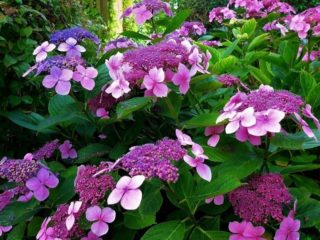Content
- 1 Description of serrata hydrangea
- 2 How serrated hydrangeas differ from large-leaved
- 3 Varieties of serrata hydrangea
- 4 Hydrangea in landscape design
- 5 Frost resistance of serrata hydrangea
- 6 Care and cultivation of serrata hydrangea
- 7 Reproduction
- 8 Diseases and pests
- 9 Conclusion
- 10 Reviews of serrata hydrangea
Serrated hydrangea is a type of garden culture. It is especially popular among domestic gardeners. And this is not surprising, because the plant has a lot of advantages, among which, in particular, it is convenient for the formation of a crown, cold resistance, high phytoimmunity, and unpretentiousness. With elementary care, the bushes grow rapidly and annually delight the summer resident with lush beautiful flowers of delicate shades.
Description of serrata hydrangea
The serrata hydrangea (hydrangea serrata) is a bushy, deciduous shrub. The root system is fibrous, spreading, up to 40 cm deep. Thanks to this feature, the plant quickly reacts to both fertilization and soil contamination. The leaf plates are green, oval, pointed at the end. Their length is 10-12 cm. There are notches along the edges, like a saw.
Most varieties of the serrated hydrangea bloom from July to September. However, in regions with a cool climate, budding may decrease until August. The diameter of the inflorescences varies between 8-15 cm.
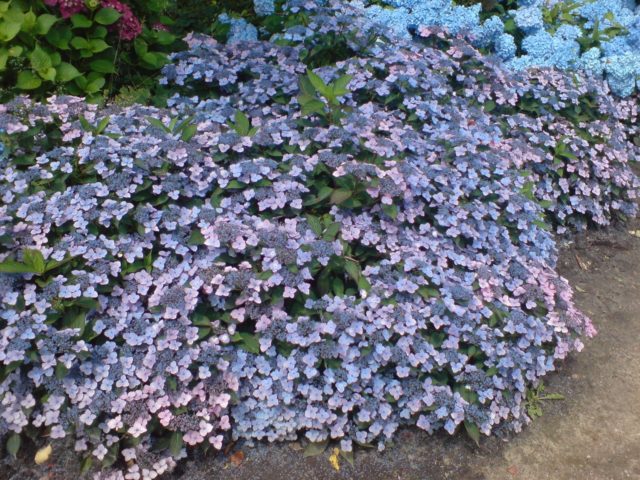
Hydrangea serrata is a thermophilic plant native to Asia.
How serrated hydrangeas differ from large-leaved
The difference between these species lies in the shape of the inflorescences. In large-leaved hydrangea, they are usually spherical and consist entirely of sterile flowers. The serrate has corymbose inflorescences. In their center there is a large number of small flowers capable of cross-pollination. Along the edges are larger, four-leafed sterile flowers that do not have reproductive organs.
Varieties of serrata hydrangea
There are many serrated types of hydrangea. Which one is better, it is impossible to say for sure. Each has its own advantages and disadvantages. Only after studying the descriptions of the most popular types, you can understand which option is most suitable.
Bluebird
Its distinctive feature is large inflorescences. The flowers included in their composition have a different color. The brightest are those in the middle. They are pink-purple with blue stamens. The shade of large flowers at the edges varies from pale pink or light purple to deep blue, purple. Throughout the flowering period, the inflorescences gradually change their shade. Bluebird bushes bloom at any age. They reach a height of 1.5 m.
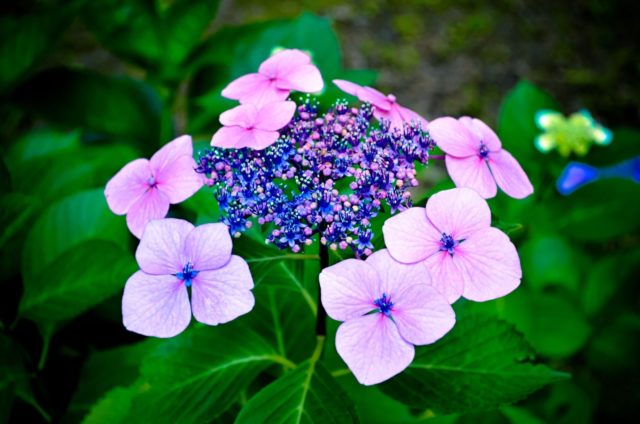
When blooming, hydrangea serrata Bluebird exudes a honey scent
Koreana
This is another undersized bush, the height of which does not exceed 150 cm. The color of the inflorescences varies from snow-white to blue. It depends on the acidity of the soil. The more acidic it is, the more blue pigment will be. Koreana does not tolerate drought well and needs regular watering.
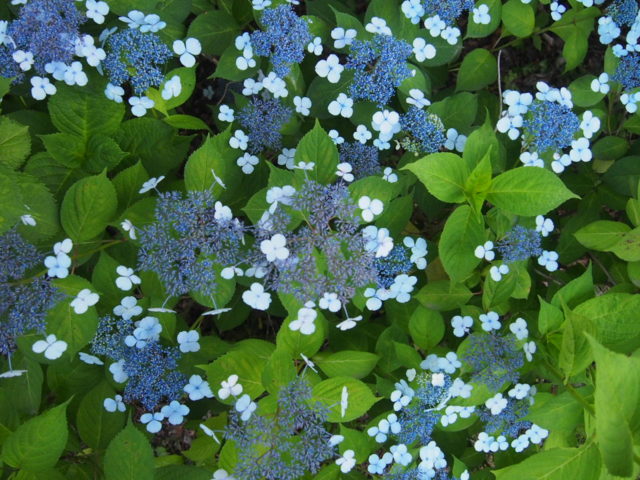
Hydrangea Koreana is one of the most popular varieties of serrata hydrangea
Preciosa
The bush grows up to 250 cm in height. It has expressive flowers, unusual leaf plates.In spring and summer, they are green, however, in autumn they acquire a burgundy hue. The inflorescences of Preciosa are no less bright. At the beginning of flowering, they are creamy green, then deep pink and before the end of flowering - crimson.
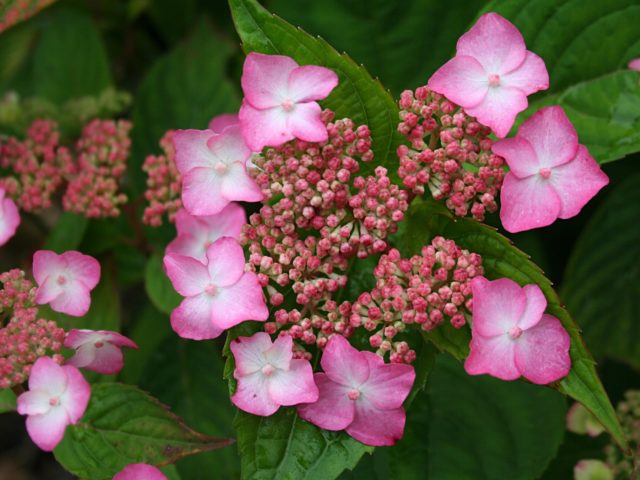
Preciosa is a tall shrub that needs regular pruning.
Golden Sunlight
This is a dwarf plant, the height of which does not exceed 1 m. Its distinctive feature is the large pointed leaves of a yellow hue, which turn green over time. The small flowers located in the center are dark pink, and the large ones along the edge are pale pink. Of all types of serrated hydrangea, this is the least frost-resistant.
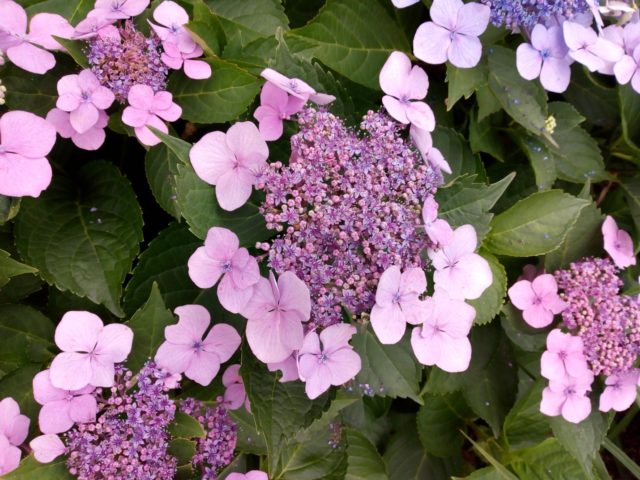
Golden Sunlight is a dwarf shrub of serrated hydrangea that can be grown in pot pots
Vierle
It is a low plant with a height of about 1 m. The shade of its inflorescences varies from lilac-blue to pink. Leaf plates are green in spring and summer, but by autumn they become burgundy or purple. Vierle does not survive in wetlands. For proper growth and development of the plant, you need to regularly feed it. Just like Golden Sunlight, it is not hardy and needs shelter for the winter.

When growing the serrated hydrangea of the Vierle variety, it is important not to overdo it with watering.
Avelrose
The bush, the height of which does not exceed 1 m, has a huge number of pink inflorescences (they can be bright or dark). A characteristic feature of this plant is the presence of violet-green leaf plates, which turn purple with the end of summer. On acidic soils, Avelrose inflorescences acquire a blue tint. The plant feels comfortable both in the shade and in the sunlight. Does not tolerate excess moisture.
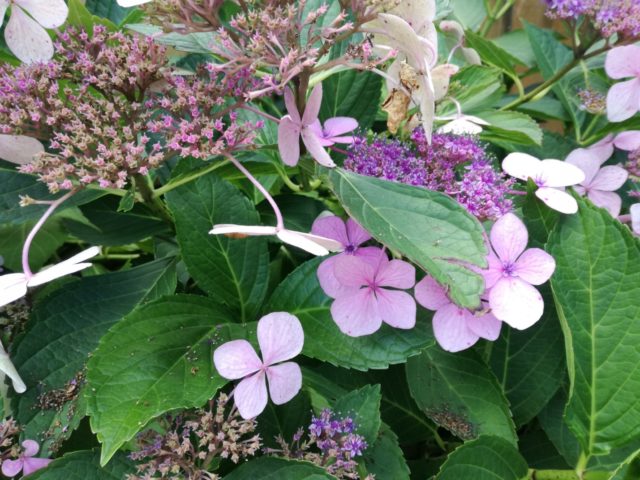
The shade of the inflorescences of the serrated type Avelrose depends on the acidity of the soil
Hydrangea in landscape design
Serrated hydrangea has no flaws, which is why designers love it so much. Due to the huge variety of color palette and shape of inflorescences, these plants play the role of a bright accent in landscape compositions. The leaf plates look unusual and thus emphasize the beauty of the bushes.
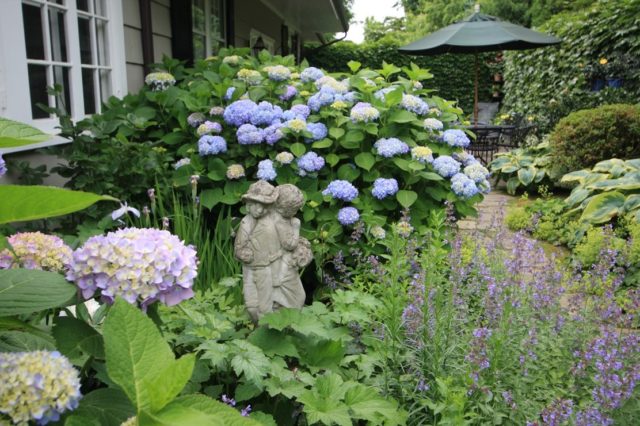
Since hydrangea has a long flowering period, hedges are often made from it, they are planted along the fence and near the walls of houses
Low-growing varieties are grown in pots.
Often, hydrangea compositions are placed in separate groups. However, they also go well with other ornamental plants. Hydrangea looks good next to birch, maple, acacia and lilac, as well as willow, bird cherry, barberry, jasmine. Also dahlias, roses, peonies, starfish, rhododendrum, azalea, astilbe are suitable for her,
Frost resistance of serrata hydrangea
The winter hardiness of the serrated hydrangea depends on the variety. Here are the indicators that the most popular types can withstand:
- Bluebird - 20 ° C,
- Koreana - 25 ° C;
- Preciosa - 20 ° C;
- Golden Sunlight - 16 ° C;
- Vierle - 18 ° C;
- Avelrose - 23 ° C.
Care and cultivation of serrata hydrangea
In order for a plant to grow and develop correctly, it must be treated with special attention. First of all, you need to choose the right place for planting, root the seedling. In the future, after this, one must not forget about constant care. Without it, the hydrangea stops blooming and begins to hurt, gradually die.
Selection and preparation of the landing site
The serrated hydrangea does not tolerate direct sunlight. Under them, her petals become too pale. However, serrated hydrangea is not suitable for full shade. Excessive darkening can cause the bushes to stop blooming. The best option is partial shade. Hydrangea should be planted in places protected from strong winds. Landing close to the building is undesirable, since in this case freezing in winter is possible.
A few days before planting, the site is dug up. The soil overgrown with weeds can be pretreated with herbicides in 2 weeks. Serrated hydrangeas love light, acidic soil that is rich in humus. They do not tolerate high lime and ash content in the earth, as it reduces acidity.
In cases where the soil is heavy and has a poor composition, a ready-made substrate is bought in advance for planting in a garden store. Some summer residents make it on their own. For this, crushed high-moor peat, turf, humus, black soil and sand are mixed in equal proportions.
Landing rules
A landing pit is made in advance. Its size should fully correspond to the size of the plant's root system. The optimum distance between the pits is 1.5 m.
The very procedure for planting a serrated hydrangea variety is simple. Water is poured into the pit and a seedling is placed. Then it is covered with earth or a pre-prepared substrate. The land near the planted plant is lightly tamped and watered. Finally, lay a layer of mulch about 10 cm thick. For this, needles or sawdust are used.
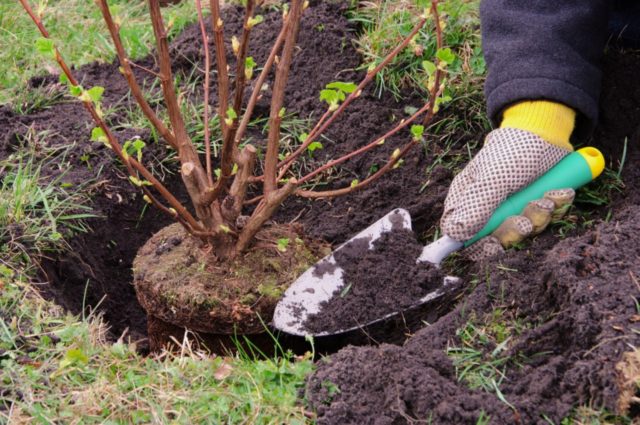
The serrated variety of hydrangea is recommended to be planted in spring or autumn.
Watering and feeding
Most serrated hydrangea varieties need regular watering. It is especially important to carry out this procedure during heat and drought. Plants are watered as the soil dries up at the root. The water should be at room temperature. If it is too cold, it needs to be warmed up. The chlorinated liquid should settle for some time. The use of rainwater is encouraged.
Under the bushes, you need to fertilize twice a year, first before and then after flowering. At the beginning of spring, 20 g of urea is dissolved in a bucket of water and the hydrangea is poured with the resulting liquid. For each bush, 3 buckets of solution are consumed. After the end of flowering, the hydrangea is fed with complex mineral fertilizers.
How to prune a serrated hydrangea
The most suitable time to prune a plant is March. Shoots are cut in such a way that 6-12 of the most powerful ones remain. The remaining branches are shortened by several buds (up to 5). Pruning the serrated hydrangea in the fall involves removing the wilting buds.
Only old bushes need radical pruning. They are shortened in such a way that stumps up to 8 cm high remain above the ground. It is not dangerous and even useful. After such pruning, new young shoots grow, which bloom profusely.
Preparing for the winter serrata hydrangea
In the fall, the bushes need to be treated with chemicals against insect pests and all kinds of infections. When all the foliage has fallen from the bush, and it becomes completely naked, it should be sprayed with a 3% solution of Bordeaux liquid. If you need a serrated hydrangea transplant, then this can be done in the fall.
Most serrated varieties have very good frost resistance, but despite this, they still need shelter for the winter. First you need to add superphosphate and potassium salt to the hole. Then you should tie the shoots into a bunch and bend them slightly to the ground. Finally, cover the plant with two layers of spunbond. The procedure is best done before freezing begins.
Reproduction
The serrated type of hydrangea can be propagated by seed, dividing, layering or cuttings. The last method is the most popular. Cuttings are usually cut from young shoots of young bushes. Traditionally, the middle part of the shoots is used, on which there are no flowering tops and lower leaves.
In order for the roots to grow faster, the cutting is placed in water with a root former (any). If this is not available, honey is added to the water (1 tsp per 250 ml). Cuttings are planted under a shelter, and in the spring, already rooted plants are transplanted to a permanent place.
For reproduction by layering, an adult bush is chosen. With the onset of spring, before the buds bloom, its lower branches are pressed to the ground, pinned, and the place of contact is sprinkled with soil. By the fall, these branches will take root. New plants are transplanted to a permanent place in the spring.
Seed propagation is usually practiced by breeders during their experiments. Specimens grown from seed material often do not adopt parental qualities.

Cuttings are a reliable and effective way of propagation of the serrated hydrangea
Diseases and pests
Excess calcium in the soil is fraught with the development of chlorosis of serrate leaves. If the green mass begins to turn yellow or pale, it is necessary to use a foliar fertilizer, which includes iron. In this case, it is important to acidify the soil by introducing peat, crushed bark or ammonium sulfate into it.
One of the most widely spread pests is aphids. The main signs of its presence are damage to young leaves, the development of fungal diseases. If the number of aphids is small, it is destroyed by natural enemies - the lacewing and ladybug. You can fight a large invasion with a homemade decoction. They make it like this: 1 kg of raw or 200 g of fresh nettle leaves, chamomile flowers or dandelion roots are poured with boiling water and allowed to brew for 24 hours. If that doesn't work, use an insecticide.
Conclusion
Serrata hydrangea is an ornamental shrub with delicate flowers, which often becomes the main decoration of the garden. The plant is not at all whimsical to growing conditions and care. Even inexperienced summer residents can cope with this. If you follow the elementary rules of agricultural technology, the plant will delight with its beauty for many years.
Reviews of serrata hydrangea
